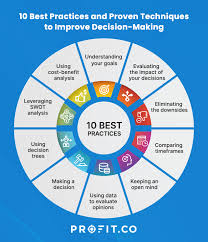Types of Decision Making Models
Decision making is a crucial aspect of our daily lives, whether it’s choosing what to eat for breakfast or making important business decisions. There are several different types of decision making models that can help individuals and organizations make informed choices. Here are some common types of decision making models:
Rational Decision Making Model
The rational decision making model is a systematic approach to decision making that involves identifying the problem, generating alternative solutions, evaluating those alternatives, and selecting the best option based on a rational analysis of the available information.
Bounded Rationality Model
The bounded rationality model recognizes that individuals and organizations may not have the time or resources to analyze all possible alternatives when making decisions. Instead, they use heuristics or rules of thumb to simplify the decision-making process.
Intuitive Decision Making Model
The intuitive decision making model relies on gut feelings, instincts, and past experiences to make decisions quickly without a formal analysis of alternatives. This type of decision making is often used in situations where time is limited or when there is incomplete information.
Behavioral Decision Making Model
The behavioral decision making model takes into account psychological and social factors that influence decision making, such as cognitive biases, emotions, and social pressures. This model recognizes that individuals may not always make rational decisions due to these external influences.
Collaborative Decision Making Model
The collaborative decision-making model involves multiple stakeholders working together to make decisions through consensus-building and group discussions. This approach can lead to more inclusive and well-rounded decisions that take into account different perspectives.
These are just a few examples of the many types of decision-making models that exist. Each model has its own strengths and weaknesses, and the most appropriate model will depend on the specific situation and context in which a decision needs to be made.
Understanding Various Decision-Making Models: A Guide to Commonly Asked Questions
- What are the four models of decision-making?
- What are the 3 models of decision-making?
- What are the 5 models of decision-making?
- What are the three types of decision models?
- What are the four 4 styles of decision-making?
- What are the 6 types of decision-making?
What are the four models of decision-making?
There are four main models of decision-making that are commonly recognized: the rational decision-making model, the bounded rationality model, the intuitive decision-making model, and the behavioral decision-making model. Each of these models offers a unique approach to making decisions and takes into account different factors such as rational analysis, cognitive limitations, intuition, emotions, and social influences. Understanding these four models can help individuals and organizations navigate the decision-making process more effectively by choosing the most appropriate approach based on the specific circumstances of the decision at hand.
What are the 3 models of decision-making?
When it comes to the types of decision-making models, there are three commonly recognized models that are frequently referred to. The first is the rational decision-making model, which involves a systematic approach to identifying problems, generating alternatives, evaluating options, and selecting the best choice based on a rational analysis. The second model is bounded rationality, which acknowledges that individuals may not have the time or resources to consider all possible alternatives and instead rely on simplified decision-making strategies. Lastly, the intuitive decision-making model emphasizes quick decisions based on gut feelings, instincts, and past experiences rather than formal analysis of options. These three models offer different perspectives on how decisions can be made effectively in various situations.
What are the 5 models of decision-making?
When it comes to the different models of decision-making, there are several commonly recognized approaches that individuals and organizations can utilize. Some of the most frequently discussed models include the rational decision-making model, bounded rationality model, intuitive decision-making model, behavioral decision-making model, and collaborative decision-making model. Each of these models offers a unique perspective on how decisions can be made effectively, taking into account factors such as logic, intuition, cognitive biases, social influences, and group dynamics. By understanding and applying these diverse models of decision-making, individuals can enhance their ability to make well-informed choices across various situations and contexts.
What are the three types of decision models?
When it comes to the types of decision making models, three common categories stand out: the rational decision making model, the intuitive decision making model, and the behavioral decision making model. The rational model involves a systematic approach to analyzing alternatives and selecting the best option based on logical reasoning. In contrast, the intuitive model relies on instincts and past experiences to make quick decisions without formal analysis. Lastly, the behavioral model considers psychological and social factors that can influence decision making, such as emotions and cognitive biases. Each of these models offers a unique perspective on how decisions are made and can be applied in various situations to achieve optimal outcomes.
What are the four 4 styles of decision-making?
There are four main styles of decision-making that individuals and organizations commonly use. The first style is autocratic decision-making, where a single individual makes decisions without consulting others. The second style is democratic decision-making, which involves group discussion and voting to reach a consensus. The third style is consensus decision-making, where all stakeholders must agree on a decision before it is made. The fourth style is collaborative decision-making, which emphasizes teamwork and open communication to arrive at a mutually agreeable solution. Each style has its own advantages and drawbacks, and the most appropriate one will depend on the specific circumstances of the decision at hand.
What are the 6 types of decision-making?
There are various types of decision-making models that individuals and organizations can utilize to make informed choices. Some common categories include the rational decision-making model, bounded rationality model, intuitive decision-making model, behavioral decision-making model, collaborative decision-making model, and incremental decision-making model. Each of these models offers a unique approach to the decision-making process, taking into account factors such as rational analysis, cognitive biases, emotions, group dynamics, and the incremental nature of some decisions. By understanding these different types of decision-making models, individuals can choose the most suitable approach based on the specific circumstances they are facing.




